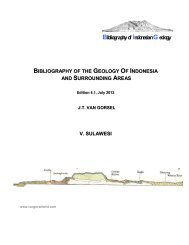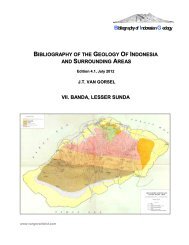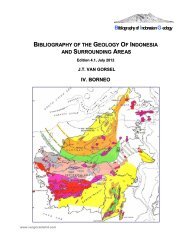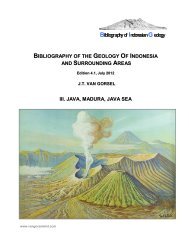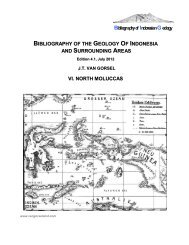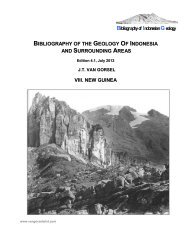Sumatra, Sunda Shelf, Natuna - Bibliography of Indonesia Geology
Sumatra, Sunda Shelf, Natuna - Bibliography of Indonesia Geology
Sumatra, Sunda Shelf, Natuna - Bibliography of Indonesia Geology
You also want an ePaper? Increase the reach of your titles
YUMPU automatically turns print PDFs into web optimized ePapers that Google loves.
II.3. <strong>Natuna</strong>, Anambas<br />
Adrian, H., L. Andria & A. Sudarsana (2005)- Horizontal well placements using V shale and facies geomodel:<br />
an example from Belanak Field, South <strong>Natuna</strong> Sea, <strong>Indonesia</strong>. Proc. 30 th Ann. Conv. Indon. Petrol. Assoc., 1, p.<br />
145-162.<br />
(Main reservoirs in Belanak Field, S <strong>Natuna</strong> Sea Block ‘B’ are U Oligocene Gabus Massive Sand and Gabus<br />
Zone-3. Massive Sand gas with thin oil rim, deposited in a fluvial channel environment. Multi-storied channel<br />
sands. Porosity ranges similar throughout field, but permeabilities are variable)<br />
Alyadrus, M.A. & R.L. Coates (1990)- Successful marginal feld development, Ikan Pari Field, <strong>Natuna</strong> Sea.<br />
Proc. 19th Ann. Conv. Indon. Petrol. Assoc., p. 345-351.<br />
(Ikan Pari Field, discovered in 1983, 50 miles NE <strong>of</strong> Udang Field. Developed with four seafloor completions)<br />
Bachtel, S.L., R.D. Kissling, D. Martono, S.P. Rahardjanto, P. Dunn & B.A. MacDonald (2004)- Seismic<br />
stratigraphic evolution <strong>of</strong> the Miocene-Pliocene Segitiga platform, East <strong>Natuna</strong> Sea, <strong>Indonesia</strong>: the origin,<br />
growth, and demise <strong>of</strong> an isolated carbonate platform. In: G. Eberli et al. (eds.) Seismic imaging <strong>of</strong> carbonate<br />
reservoirs and systems, AAPG Mem. 81, p. 309-328.<br />
(High-res 2D seismic survey over Segitiga Platform (1400 km2), E <strong>Natuna</strong>-Sarawak Sea. Terumbu Fm<br />
carbonate up to 1800 m thick, subdivided into 12 seismic sequences, showing (1) initial isolation; (2)<br />
progradation /coalescence; (3) backstepping; (4) terminal drowning. Platform originated as 3 smaller<br />
platforms on highs, separated by deep intraplatform seaways. Three platforms merged into composite platform<br />
in M-U Miocene. Rapid end Miocene sea level riset caused major backstepping <strong>of</strong> carbonate margins (and<br />
drowning <strong>of</strong> <strong>Natuna</strong> field carbonate platform to E) resulting in smaller platform in Lower Pliocene. Rapid<br />
subsidence at end <strong>of</strong> E Pliocene, caused terminal drowning)<br />
Ben-Brahmin, L. et al. (1999)- Characterization <strong>of</strong> seismic anomalies using converted waves: a case <strong>of</strong> history<br />
from East <strong>Natuna</strong> Basin. Proc. 27th Ann. Conv. Indon. Petrol. Assoc., p. 295-302.<br />
Bennett, M. (1999)- Intra-Muda shallow gas in Cumi-Cumi PSC, <strong>Natuna</strong> Sea- a driller's nightmare becomes a<br />
geophysicist's dream. Proc. 27th Ann. Conv. Indon. Petrol. Assoc., p. 303-321.<br />
(M Miocene age Intra-Muda Fm. sandstones draped over inversion feature. Strong seismic amplitude anomaly<br />
over crest, with 'flatspots' around flanks <strong>of</strong> structure and gas-charged in Tenggiri 1 and Mako 1 wells)<br />
Bhikuningputra, D. (1986)- Seismic stratigraphic study to evaluate reservoirs and seals <strong>of</strong> the <strong>Natuna</strong> area. In:<br />
Seismic Stratigraphy I, Proc. Joint ASCOPE/ CCOP Workshop, Jakarta 1986.CCOP Tech. Publ. 17, p. 157-180.<br />
Bothe, A.C. (1928)- Geologische verkenningen in den Riouw-Lingga archipel en de eilandengroep der Poelau<br />
Toedjoeh (Anambas- en Natoena-eilanden). Jaarboek Mijnwezen Nederl. Oost-Indie 54 (1925), Verh. 2, p. 101-<br />
152.<br />
(Geological reconnaissance surveys <strong>of</strong> Riau Archipelago (common granites), Anambas Islands (mainly<br />
granites) and <strong>Natuna</strong> islands (metamorphic rocks, possibly Jurassic radiolarian chert, serpentinites, granites))<br />
Budiyono (2002)- Forel field reservoir characterization and field assessment, West <strong>Natuna</strong> Basin <strong>Indonesia</strong>.<br />
M.Sc. Thesis Univ. Texas, Austin, p. (Unpublished)<br />
Burton, D. & L.J. Wood (2010)- Seismic geomorphology and tectonostratigraphic fill <strong>of</strong> half grabens, West<br />
<strong>Natuna</strong> Basin, <strong>Indonesia</strong>. AAPG Bull. 94, 11, p. 1695-1712.<br />
(Study <strong>of</strong> Eo-Oligocene synrift architectures <strong>of</strong> Cenozoic grabens in W <strong>Natuna</strong> Basin (WNB) from Gabus and<br />
Belanak 3D seismic surveys. Five facies: fluvial, deltaic, alluvial fan, shallow lacustrine and deep lacustrine.<br />
Synrift stratigraphy shows strong tectonic control. Hydrocarbon in basin restricted to upper synrift- postrift<br />
reservoirs in M Miocene inversion anticlines, but synrift may have potential)<br />
<strong>Bibliography</strong> <strong>of</strong> <strong>Indonesia</strong> <strong>Geology</strong> v. 4.1 143 www.vangorselslist.com July 2012



